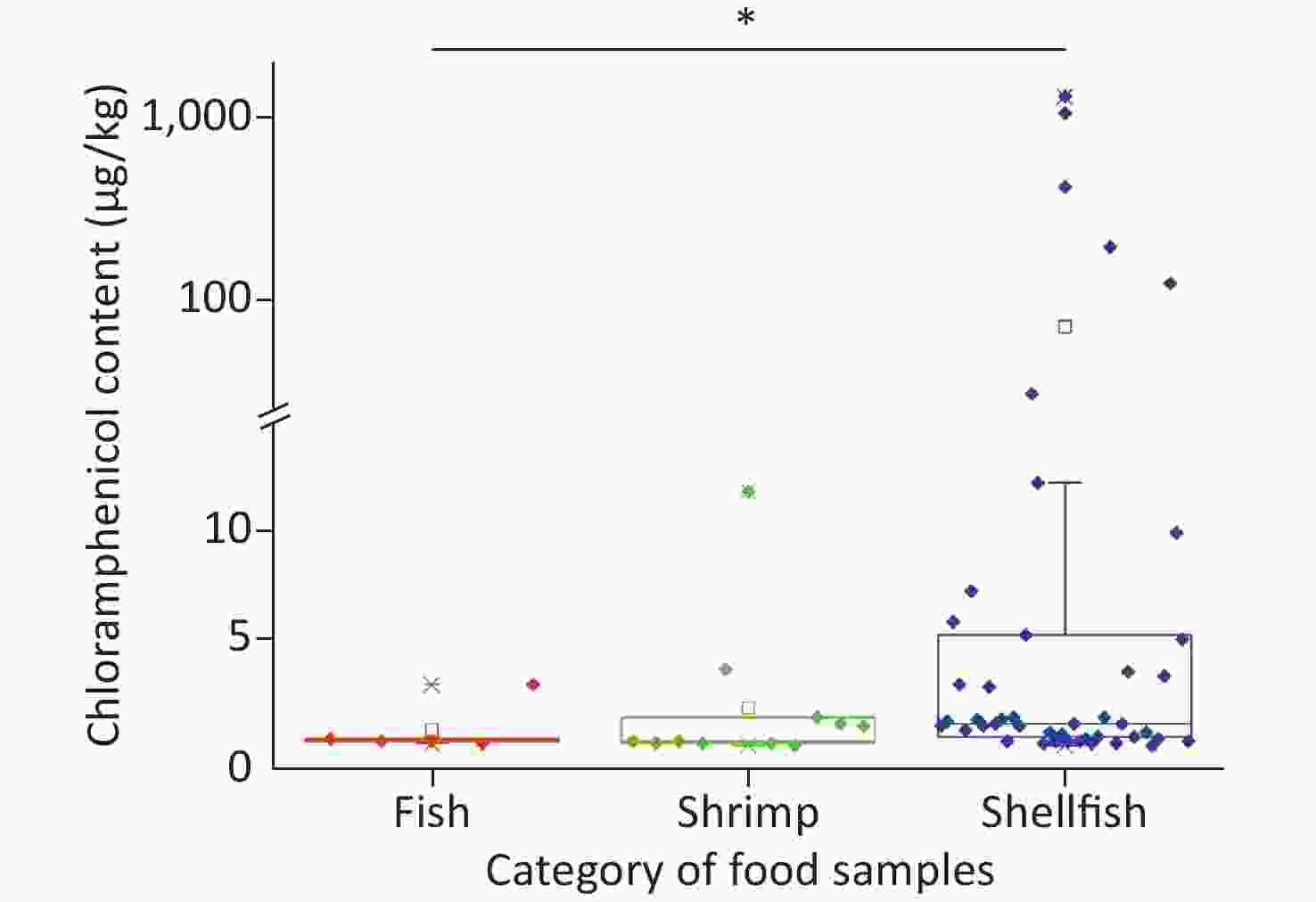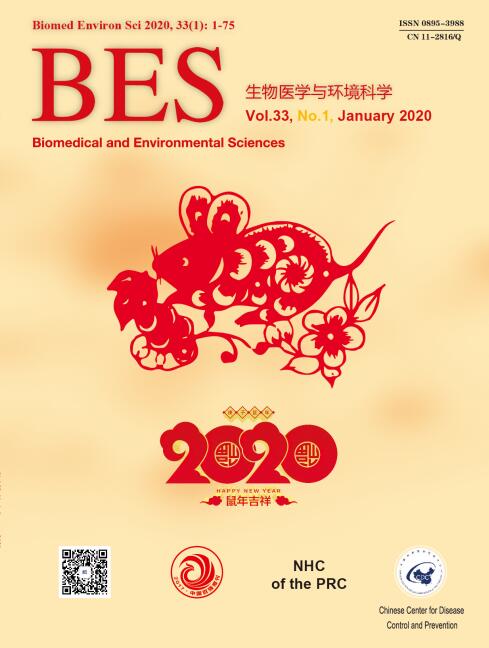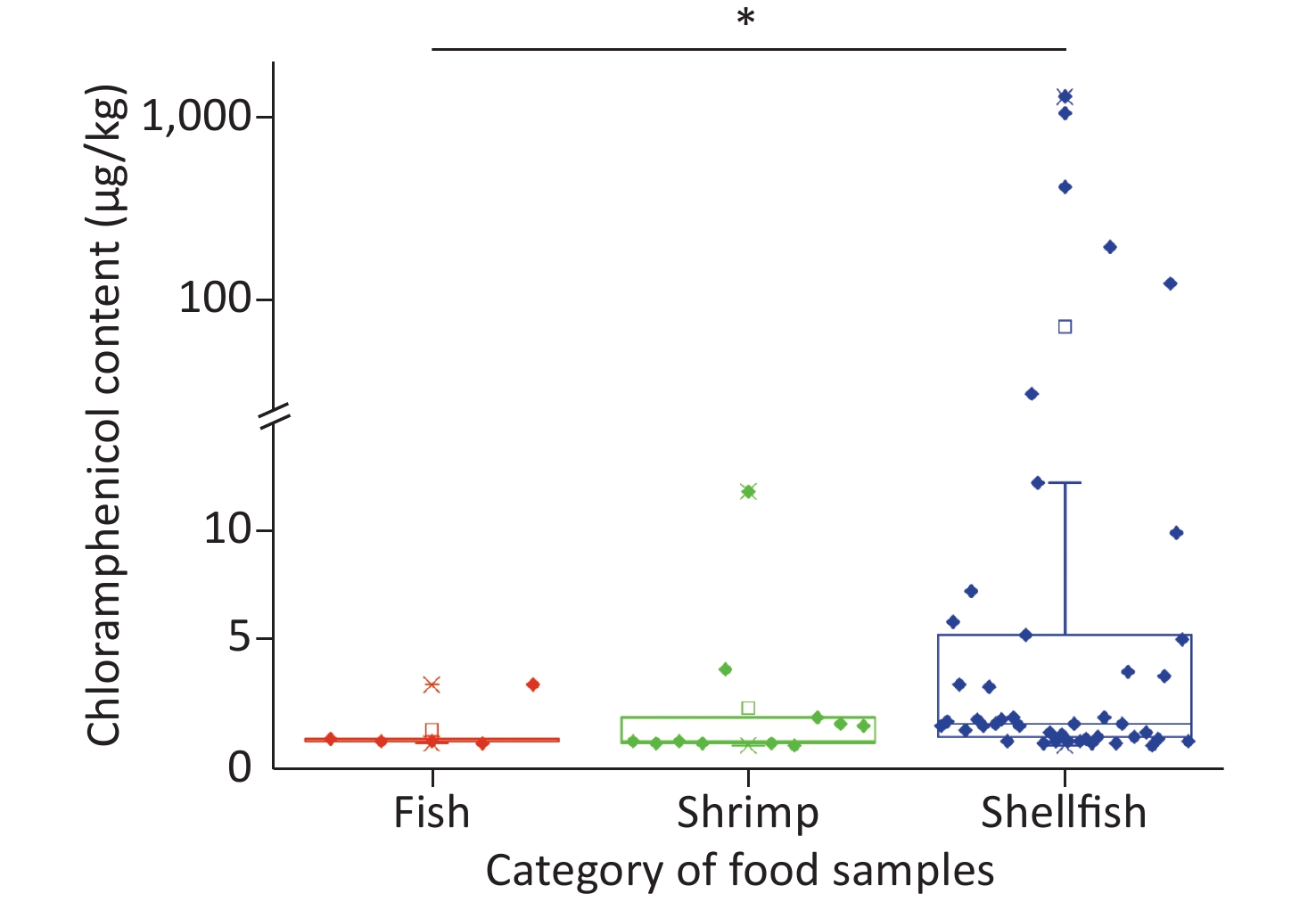-
The use of antibiotics to maintain animal health has widely been practiced, for both therapeutic and prophylactic purposes. Along with the identification of serious adverse effects of some antibiotics on human and domestic animals[1], chloramphenicol, nitrofurans and malachite green have been prohibited from agricultural use by the Ministry of Agriculture and Rural Affairs of the China since 2002; moreover, duomycin and oxytetracyclines have been prohibited from regular application in agricultural and fishery industries, while they are allowed for uses following veterinary prescriptions, according to the rules established in 2006 and 2016 in China. However, violation to the regulations in antibiotic and chemical limitations is not uncommon in China.
Crystal violet is a dye with antifungal and antibacterial properties, while leuco-crystal violet is a reduced form of crystal violet. Crystal violet and leuco-crystal violet are not mentioned in the regulations established in China for safe agricultural and aquacultural production, however, owing to their potential carcinogenic, genotoxic and teratogenic properties in many animal species, neither of them has been registered as veterinary drug in any nation. Moreover, official report of the levels of crystal violet, malachite green and their metabolites in aqua products exported from China started to be required by the European Union in 2008. As an estimation of about 63,000 tonnes of antibiotics used in aqua products and livestock in 2010 is expected to increase by about 67% by the year 2030, with a predicted doubled increase in China[2,3], the burden of such chemicals, particularly those prohibited from use, in domestic animals has received extensive concerns from the public. The aim of this study was to investigate the presence and levels of residues of a series of antibiotics/chemicals currently prohibited from agricultural/aquacultural use, in various agricultural products commercially available in Guangzhou, with their safety limits in foods serving as references.
A total of 746 samples of aquatic products (including fish, shellfish, and shrimps), eggs and milk (powder and liquid milk) were collected from various retailers in each of 12 districts of Guangzhou during the period between 2013 and 2015, during summer (from mid-May to mid-June) and autumn (from mid-October to mid-November) in each year. Food samples from three streets (two central and one remote) in each district were randomly selected as the monitoring sites, and from each site food samples were purchased from supermarkets, agricultural wholesale markets, shops, and restaurants. The aquatic products were grown in either marine aquaculture fields or fresh water in fishponds. It was unclear which proportion of aquatic product samples experienced sufficient depuration before going to the markets. Samples were packed in sterile polyethylene bags with labels and transported in cold cabinets (under 10 °C) within 2 hours to the laboratory. The distribution of various categories of food samples in each year were indicated in Supplementary Table S1 (available in www.besjournal.com).
Food categories Number of samples collected in different years 2013 2014 2015 Total Aquatic products 36 216 110 362 Milk and its products 119 168 0 287 Eggs 37 60 0 97 Total 192 444 110 746 Table S1. Distribution of food samples of three major categories collected in each year
Chloramphenicol was obtained from the National Institutes for Food and Drug Control (Beijing, China) (purity of 99.4%). Semicarbazide hydrochloride (SEM), 3-amino-2-oxazolidinone (AOZ), 1-aminohydantoin (AHD) and 3-amino-5-morpholinomethyl-2-oxazolidinone (AMOZ), the metabolites of furacilin, furazolidone, macrodantin, and furaltadone, respectively, were obtained from Dr. Ehrenstorfer GmbH (Augsburg, Germany). Malachite green (oxalate) was purchased from Amresco (Shanghai, China); crystal violet, leukomalachite green, and leucocrystal violet were purchased from the National Institute of Metrology (Beijing, China). Methanol, acetonitrile, formic acid, dimethyl sulfoxide, and 2-nitrobenzene formaldehyde were of chromatographically pure grade. Pure water (grade 1) was used in the preparation of all solutions.
The content of each antibiotic residue was detected by UPLC-MS/MS (model XevoTQ-S, Waters Corp., Milford, MA), according to the procedures previously reported[4-6], with minor modifications. Briefly, samples were protein precipitated with acetonitrile, and extracted by ethyl acetate and acetonitrile; then they were cleaned up by using Oasis MCX column (Waters Corp., Milford, MA). Chloramphenicol and other chemicals were separated on Acquity Beh C18 chromatographic column (2.1 mm × 100 mm, 1.7 μm) with acetonitrile-water on gradient elution as the mobile phase, under the following conditions, then determined by mass spectrometry. The parameters and materials in the system of UPLC (for determining residues of oxytetracycline, tetracycline, chlortetracycline, malachite green and crystal violet) and UPLC-MS/MS (for determining residues of chloramphenicol and nitrofuran metabolites) analyses are indicated in Supplementary Tables S2 and S3 (available in www.besjournal.com). The gradient elution for each antibiotic (except for duomycin and oxytetracycline, where gradient elution was unnecessary) was performed in accordance to related national standard of the People’s Republic of China, involving determination of the recovery of chloramphenicol (96.3%–110.5%, SD ≤ 7.0%), that of nitrofuran metabolites (87.9%–99.4%, SD ≤ 11%), and that of malachite green, crystal violet, leuco malachite green and leuco crystal violet (90.0%–108.0%, SD ≤ 10%). SPSS 22.0 software was used to analyse data of eachantibiotic detection. The levels of chloramphenicol varied widely, not following normal distribution, so they were regarded as quantal data and analysed by using Kruskal-Wallis H tests, using P < 0.05 as the criterion for statistical significance.
Antibiotic Mobile phase Flow rate (mL/min) Column temp (°C) Sample injection (μL) Chloramphenicol H2O, Acetonitrile, 10mmol/L ammonium acetate 1 40 25 Duomycin/Oxytetracycline Acetonitrile, 10 mmol/L sodium dihydrogen phosphate solution (35:65) 0.2 37 10 Nitrofuran metabolites Acetonitrile, 0.1% formic acid (containing
0.5 mM ammonium acetate)0.2 30 10 AOZ AMOZ AHD SEM Other compounds Acetonitrile, 50 mmol/L of ammonium acetate 0.25 40 10 Malachite green Leuco malachite green Crystal violet Leuco crystal violet Table S2. The parameters and materials used in the UPLC system for the detection of each antibiotic
Antibiotic Transition reaction (m/z) Collision energy (V) Cone voltage (V) Chloramphenicol 320.9/151.9 −25 −72 Nitrofuran metabolite AOZ 236/134 10 77 AMOZ 335/291 9 60 AHD 249/134 10 80 SEM 209/166 8 50 Other compounds Malachite green 329.2/313,2 34 30 Leuco malachite green 331.0/239.1 30 30 Crystal violet 372.2/356.2 40 30 Leuco crystal violet 374.3/238.2 26 30 Note. Electron spray ionization (ESI) was applied to the detection of each chemical. The ion source temperature for the detection of chloramphenicol, each nitrofuran metabolite, and the other compounds were 550, 540, and 600 ℃, respectively; the capillary voltage for the detection of those categories of compounds were −4,500, 3,500, and 2,500 V, respectively; the desolvation temperature for the detection of the compounds were 400, 350, and 350 ℃, respectively; the nitrogen flow for the detection of the compounds were 750, 700, and 700 L/h, respectively; and the cone flow for the detection of the compounds were 50, 100, and 100 L/h, respectively; the limit of detection for the compounds were 0.1, 0.5, and 1 μg/kg, respectively. Table S3. The Parameters of MS system for different antibiotic
Analysis of totally 746 food samples with 2,438 determinations, 6% turned out to be quantifiable (above the detection limit). As indicated in Supplementary Table S4 (available in www.besjournal.com), the limit of detection of chloramphenicol was 0.1 µg/kg, that of duomycin and oxytetracycline being 500 µg/kg, that of the metabolite of each nitrofuran compound (furazolidone, furaltadone, furacilin, and macrodantin) being 0.5 µg/kg, and that of malachite green, leuco-malachite green, crystal violet, and leuco-crystal violet being 1 µg/kg. Eight out of the 11 antibiotics/chemicals were detected in various food samples, which demonstrated detection rates ranging from 0 to 12%, that of chloramphenicol being the highest (12%), followed by that of leuco-malachite green, furazolidone, and furacilin (9%, 9%, and 6%, respectively). Notably, none of duomycin, oxytetracycline or leuco-crystal violet was detected, each in more than 150 food samples. As indicated in Table 1, among the antibiotics/chemicals positively detected chloramphenicol was present unexceptionally in aquatic foods (24% of the 362 samples), but it was undetectable in egg and milk samples. Likewise, furacilin metabolite was detected in aquatic products (8%) but not in eggs; furazolidone metabolite was detected in 11% of the aquatic products, while only 1 of 36 (2.7%) egg samples was detected positive; leuco-malachite green was detected in 9% of aquatic samples, with the other categories of samples untested. The major aquatic food involved in chloramphenicol, furazolidone, furacilin, and leuco-malachite green was shellfish, shrimp, shrimp, and fish, respectively. Between different years, no obvious difference in the rate of detection of each chemical in each category of food products was observed (data not shown).
Antibiotic Number of samples/tests Limit of detection (μg/kg) Above detection limit Number Rate (%) Chloramphenicol 746 0.1 87 12 Duomycin 156 500 0 0 Oxytetracycline 156 500 0 0 Furazolidone 182 0.5 17 9 Furaltadone 182 0.5 1 1 Furacilin 182 0.5 11 6 Macrodantin 182 0.5 2 1 Malachite green 163 1 2 1 Leuco-malachite green 163 1 14 9 Crystal violet 163 1 1 1 Leuco-crystal violet 163 1 0 0 Total 2,438 − 135 6 Table S4. Limit of detection of each chemical and its rate of detection in various food products obtained from Guangzhou in 2013 through 2015
Antibiotic Food class No. of samples Samples detected positive Positive detection rate (%) Median level
(min-max), µg/kgMajor food involved Food Detection rate (%) Chloramphenicol Aquatic 362 87 24 1.2 (0.1−1,313) Shellfish 62 Egg 96 0 0 − Milk 288 0 0 − Furazolidone metabolite (SEM) Aquatic 146 16 11 11.5 (1.9−248) Shrimp 25 Egg 36 1 3 4.3a Furacilin metabolite (AOZ) Aquatic 146 11 8 0.8 (0.5−3.0) Shrimp 19 Egg 36 0 0 − Leucomalachite green Aquatic 163 14 9 3.2 (1.0−251) Fish 9 Note. aA simple value instead of a median was applicable. SEM, Semicarbazide hydrochloride; AOZ, 3-amino-2-oxazolidinone. Table 1. Level of each antibiotic/chemical in each class of foods sampled from different districts of Guangzhou, China during 2013 to 2015
Antibiotic/chemical contamination in China has been attributed to discharge of industrial waste water to surface water and some seashores, and abuse of antibiotics in the medical/prophylactic essence of aqua-life and livestock husbandry[7]. Indeed, oxytetracycline was detected in a south China coastal environment to the concentration of 15,163 ng/L[8], malachite green and chloramphenicol in 10.6% (mostly turtles) and 8.3% samples (mostly mandarin fish) of aqua lives in Dong Ting Lake located in central-south China[9], and nitrofuran metabolites in sea cucumber at an east China coast[10]. Farmers who practice aquaculture may not be knowledgeable regarding legal and appropriate use of antibiotics and the effects of overdosing. According to 2016 Guangdong Statistical Yearbook on Agriculture, there were about 367,000 part-time fishery workers and 70,000 temporary workers in Guangdong Province in 2015, taking 28.8% and 5.5% of all fishery workers, respectively[11]. Moreover, the regulations on withdrawal period limit may often be ignored, and unauthorised drugs may even be applied by some farmers/retailers.
Regarding the rates of positive detection of each antibiotic/chemical in various aquatic products, as shown in Figure 1A, regardless of central or peripheral districts, the highest rates of positive detection were found in shellfish, followed by those in shrimp (both being marine), with the lowest rates in freshwater fish. Particularly for chlormphenicol, as shown in Figure 1B, it was most frequently detected positive in shellfish, much less frequently in shrimp and fish. Moreover, among various subclasses of shellfish, as shown in Figure 1C, chloramphenicol was detectable in all (100%) samples of both mussel and shellfish subgroups, while 67%, 63%, 40%, and 25% in clam, tape, scallops, and raw oyster samples, respectively.

Figure 1. Distribution of positive detection of all antibiotic classes (A) and chloramphenicol solely in aquatic products per category per district group (B) and the rate of chloramphenicol detection in each sub-class of shellfish (C).
Figure 2 shows graded values of chloramphenicol in various aquatic products, where highest level of chloramphenicol was observed in shellfish, drastically lower in shrimp, and the lowest in fish. Is the contamination of aquatic products with chloramphenicol attributable to relevant pollution of the marine environment, the discharge of chemicals from industries, and/or delivery by farmers/fishers? A previous study indicated higher levels of antibiotics (chloramphenicol included) in the Pearl River while most tested antibiotics around the Victoria Harbour in Hong Kong, China, where the Pear River joins the sea, were under the limit of detection[12]. Moreover, a recent report from China indicated that the number of detectable antibiotics in rivers, including the Pearl River, were greater than that in seas, such as the South China Sea[13]. These reports suggest that the relative abundance of the prohibited chemicals in shellfish and shrimp may not be caused by marine pollution, while it could be associated with the delivery of these chemicals to the fields isolated for marine fishery. Additionally, since the lifespan of shellfish is relatively long, ranging from two to twenty years if there is no predation, they could accumulate chemicals more actively than faster growing domestic fish. As for the absence of those chemicals in eggs and milk, the lifestyle of domestic animals, featured by interrupted exposure to the chemicals (through access to water and feeds), may be contributive, as compare with aquatic lives, which are always exposed to the aquatic environment, favouring accumulation.

Figure 2. Levels of chloramphenicol in aquatic samples further classified into fish, shrimp, and shellfish. Data are real values of determinations; the horizontal bars indicate median levels, and boxes include values from 25 to 75 percentiles, while the vertical bars stand for. *P < 0.05, comparison was made between the three groups by Kruskal-Wallis H tests.
To the limitation of chemicals determined in this study, milk, and eggs are probably safe for consumption; however, control of water pollution and prohibition/instruction of chemical/antibiotic use in aquatic lives have to be strengthened.
Author contributions ZHANG Wei Wei, HU Ke Qi, and LIU Yun Gang designed the study and interpreted the results. ZHOU Zhi Feng and SHI Ming provided important comments on the interpretation of the results. MHUNGU Florence collected test data and drafted the manuscript. LIU Yun Gang revised the draft manuscript.
Acknowledgments The authors are grateful to the Chinese Ministry of Commerce for offering Florence Mhungu a two-year scholarship, and Y. Luo and N. Zhu for providing technical assistance in data analysis.
Conflicts of interest The authors declared that they have no conflict of interest.
Contamination of Prohibited Substances in Various Food Products in Guangzhou, China
doi: 10.3967/bes2020.010
- Received Date: 2019-07-16
- Accepted Date: 2019-11-13
| Citation: | MHUNGU Florence, HU Ke Qi, ZHANG Wei Wei, ZHOU Zhi Feng, SHI Ming, LIU Yun Gang. Contamination of Prohibited Substances in Various Food Products in Guangzhou, China[J]. Biomedical and Environmental Sciences, 2020, 33(1): 68-71. doi: 10.3967/bes2020.010 |








 Quick Links
Quick Links
 DownLoad:
DownLoad:
